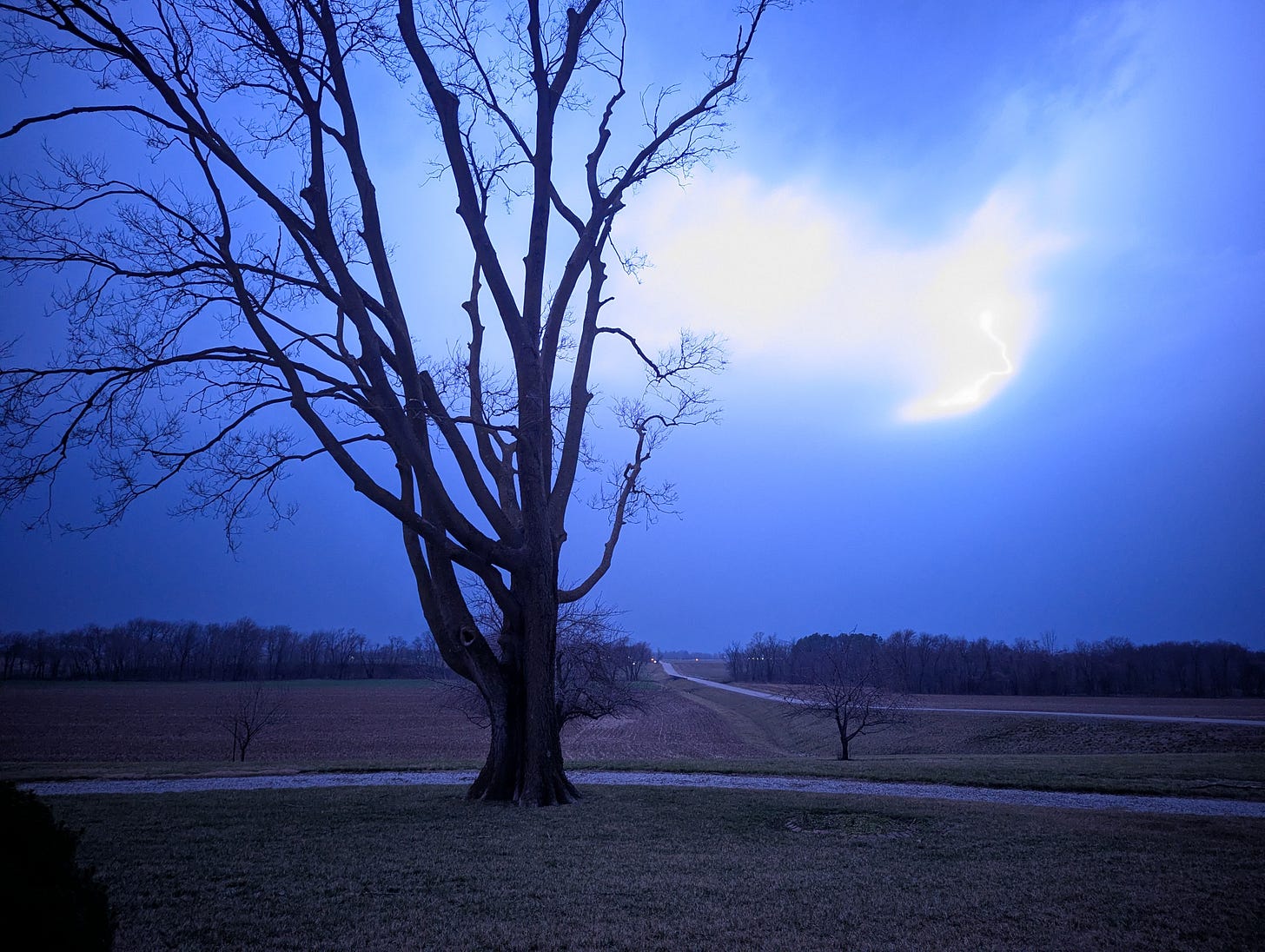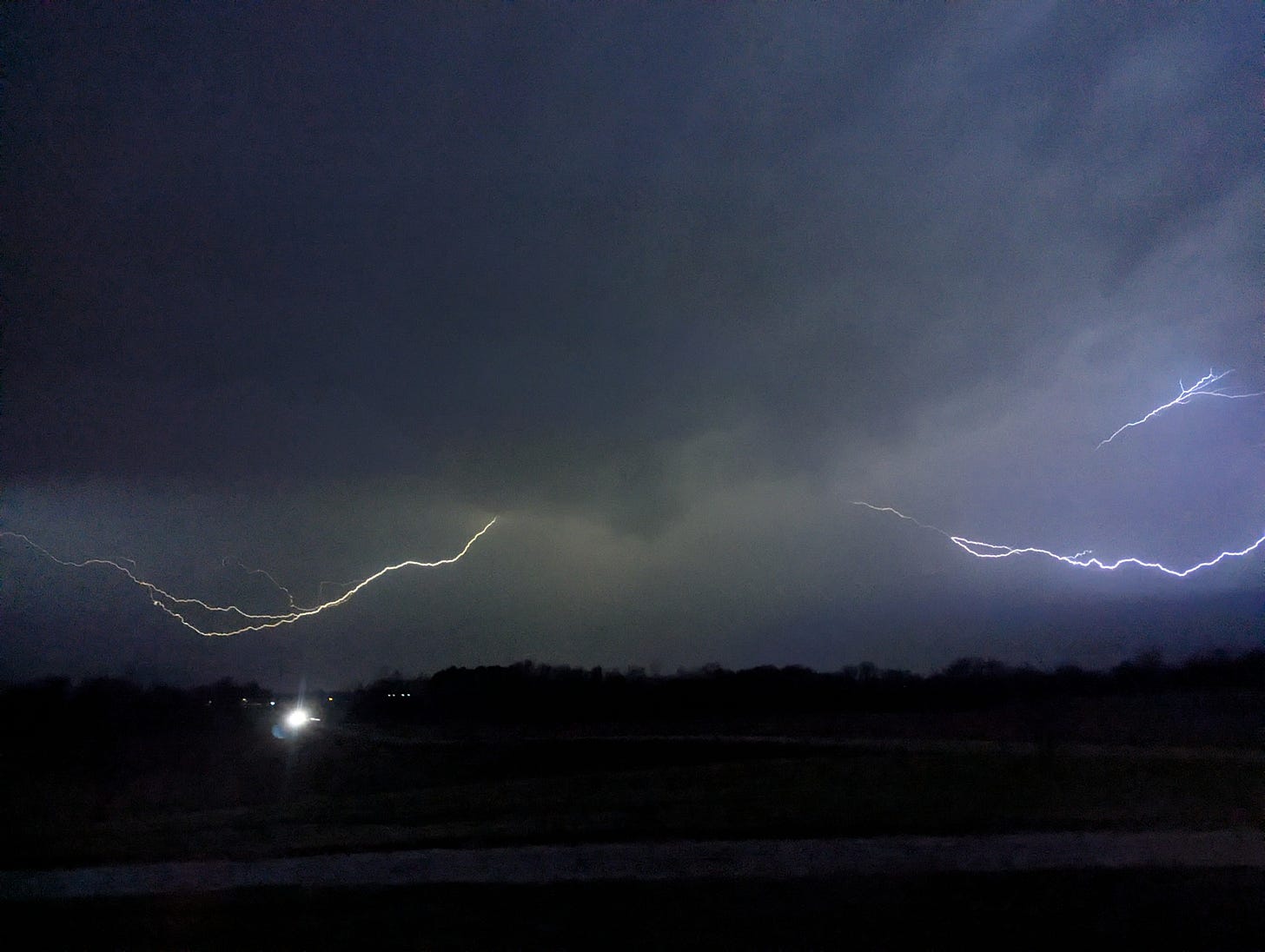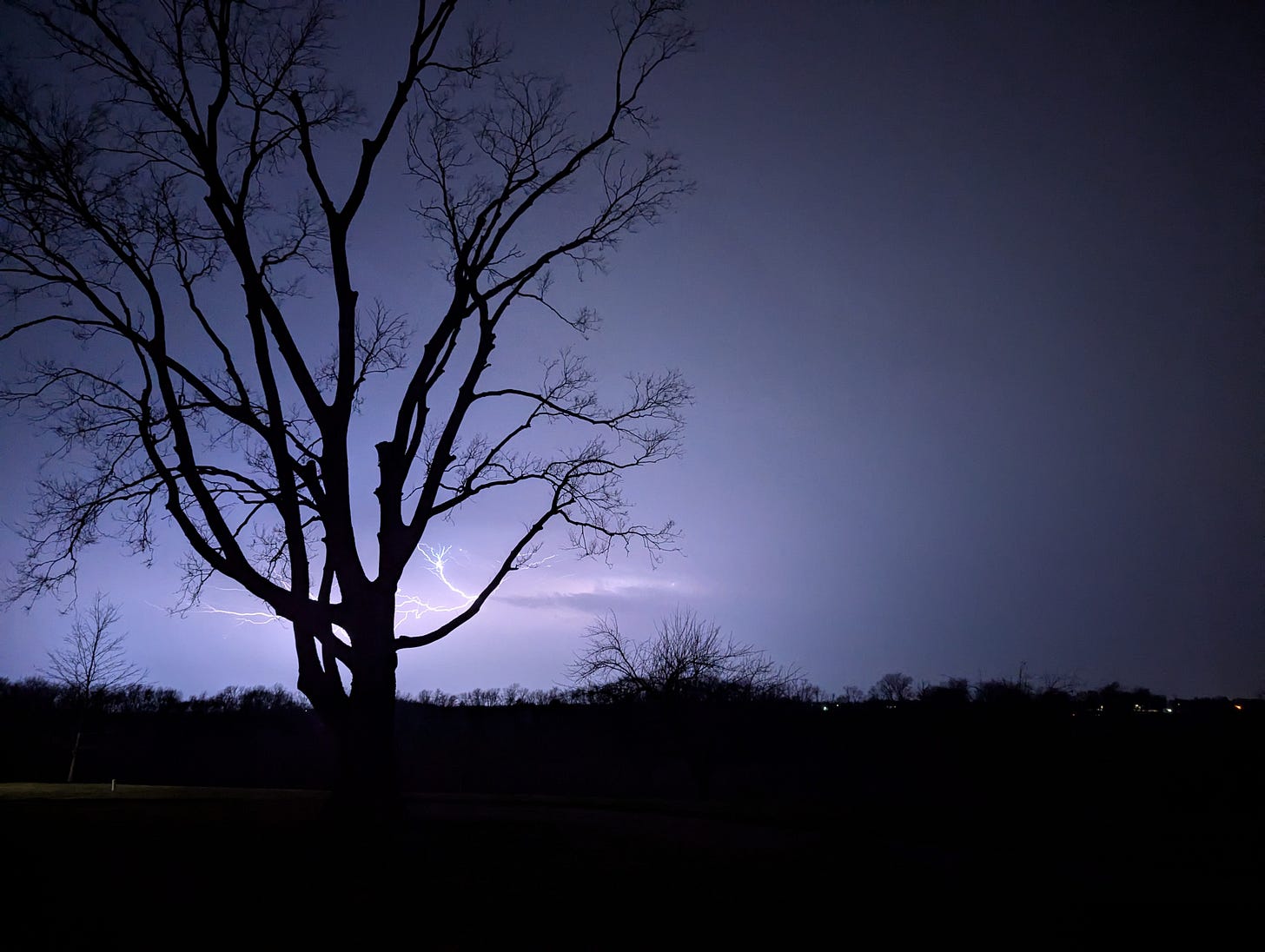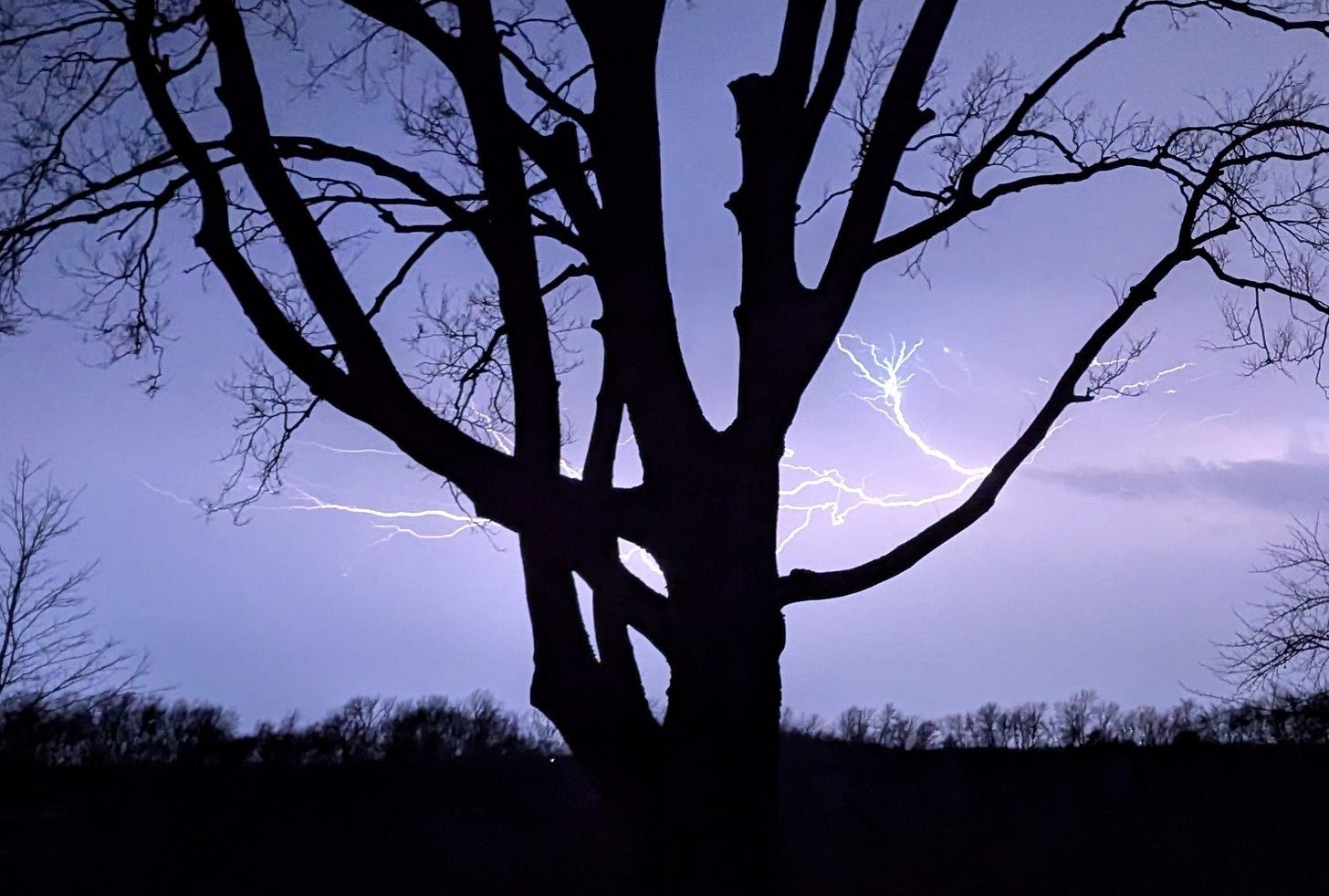It’s been a bit of a writer’s block week for me. I started writing posts about St. Patrick, Saturday Night Live, and going to brick and mortar movie theaters (all of which I intend to finish…?), but nothing took. Then, Friday night, we had a classic Midwestern storm. And that's what my brain has decided to latch onto.
I love a good thunderstorm. The distant flashes, the rolls and rumbles of thunder, the potential for a jump-scare crash at any moment. I know that thunderstorms aren’t universally considered a calming experience, but they sure as heck are for me.
For a long stretch of my childhood, my brother and I fell asleep every night to the sound of thunder playing on a cassette tape. I also have fond memories of being called out to the porch by my parents to watch the rain and the lightning from the safety of our little wooden bench. My dad still sends me videos of the best storms so that I can see his view from the porch.
About a decade ago, we were downstate on the family farm, and my little nephew (then age 5ish) was in town from Montana. A thunderstorm rolled in, and he was petrified. I talked to him about how we were safe in the farmhouse and that we could just watch the lightning and enjoy the sound of the thunder, but it was little comfort to him. I had no idea, at that time, that big thunderstorms were a uniquely Midwestern experience.
It was only two years ago that I was in southwestern Missouri for a college reunion when a storm rolled in. My two friends and I were warm and cozy in the cabin we’d rented, and I was ready to make popcorn and enjoy the show that the storm provided when one of my friends made the comment that she just can’t get used to the storms in Missouri. They’ve made her nervous since college. “Wait… Don’t you have thunderstorms in Idaho?” I asked. “No, not like this,” she told me. Suddenly my little nephew’s fears made total sense.
Here is what I have since learned: A single unit of thunderstorm is called a storm cell. A storm cell consists of an updraft and downdraft of air that create loops. The weather that we experience as a result of a storm cell is a single storm, which typically lasts for 20 to 30ish minutes (and is about 15ish miles wide). A single storm cell is what I would refer to as “a tease.” When we say “thunderstorm” in the Midwest, we actually mean a multicell storm, many overlapping storms caused by many stormcells that result in an evening of exquisite chaos.
So why the midwest? Well, as of last night, I know the answer! Continental polar air masses, which are cool and dry, come down from Canada. They crash into warm/moist maritime tropical air masses, which are coming up from the Gulf of Mexico, and a fistfight ensues. The eastern states are protected from this altercation by the Appalachian Mountains, an the western states are protected by the Rocky Mountains. I found this explanation from the Midwestern Regional Climate Center really enlightening.
There is also a lot of variation in the storms across the midwest. The further south you get, for instance, the more lightning and thunder you’ll experience. My buddy and I used to chat about how the storms here in Chicago are nothing compared to the ones we remembered from home. I am from southern Illinois, just across from St. Louis, and he is from central Oklahoma. A few months back, I sent him this post from Data Is Beautiful on Instagram, which shows a map of the annual mean lightning strike density for the continuous United States from 2017 to 2023 (created by Reddit user u/adkinsadam1, using data from the National Lightning Detection Network). It was super validating to see that both of our hometowns receive an average of 20 lightning strikes per square mile per year (similar to central Louisiana), whereas Chicago receives only 6-10.
Friday night’s storm started while we were in a restaurant celebrating my Mom’s birthday. Our table (and many others) would cheer every time the power would go out or come back on again. It went out 22 times during our meal. At one point, a server clapped his hands above his head dramatically and the lights turned back on at that very instant. The crowd went nuts!
By the time we made it back to the farm, the lightning was putting on a fantastic show, which Stephen and I were able to enjoy from the front porch (until safety dictated that we take the party inside). I made a game out of trying to get a picture of the lightning. Out of 121 photos, I managed to catch the lightning three times (visible bolts; not just illuminated clouds). Check it out:
In that last one, the lightning appears to be coming from the tree itself. It’s most likely just off in the distance, at the perfect angle, but it really looks like the tree is producing the bolts. A quick search told me that there is a phenomenon where a tree or other plant produces weak electrical sparks during a storm, called coronas, but it sounds as though those usually come from the pointed ends of leaves. This tree is naked as a jaybird, so that can’t be it. …Right? If you know anything about this kind of thing, please chime in! In the meantime, here is a closer look:
Bonkers, right?
Anyway, one other fun thing I found this weekend: While we can’t predict exactly where lightning will strike, there are tools to help us figure out where it struck! So the next time you see lightning and hear an immediate clap of thunder, and find yourself thinking “DUDE. How close was that??” check out the Spark Map on Weather Bug or the Lightning Map on LightningMaps.org.
A Few More Treasures for the Road
。・:*˚:✧。
I recently discovered two excellent vintage Sesame Street tracks that particularly appealed to me because they function as calming exercises. These would be great for the kids in your life, but I’m also betting they would benefit you as well! In “Grover Takes a Walk” (1972), lovable, furry old Grover asks that you lie on the floor and imagine that he is teeny tiny and taking a walk across your body from toe to head. Here it is on Spotify and on YouTube. In “Up Goes the Castle” (1979), your old pal, Ernie, asks you to imagine a little castle on your tummy that rises up like a mountain or falls down like a valley each time you breath. Here it is on Spotify and on YouTube.
。・:*˚:✧。
You may have noticed that today is St. Patrick’s Day! If you hadn’t realized though, or if you were just too darn busy to do anything fun, you can get a second chance tomorrow by helping me revive a largely forgotten holiday: Sheelah’s Day. While there is a real lack of documentation proving that she ever existed, Sheelah is traditionally believed to have been the wife of St. Patrick and her special day was traditionally celebrated on March 18, as sort of a St. Patrick’s Day Part 2.
Some believe that she wasn’t a real person, but a reference to the sheela na gig: stone grotesques that can be found around Europe (but particularly in Ireland) featuring a sort of alien-looking figure proudly showing off its oversized vulva. No one really knows what that’s about, but she seems like a fun gal.
The holiday fell out of style in Ireland after the 19th century, and I don’t think it ever made it’s way to the US. It’s still observed by the Irish diaspora of Canada and Australia, however, and I think we should jump on that bandwagon!
Thanks, gang! Until we meet again!








Florida in the summertime is a blast if you like thunderstorms! Every day around 2:00pm the giant clouds roll in with a killer laser light show (fun as long as you're not driving). Hurricane parties are fun too as long as it's a category three or less.
But Midwest storms are a different beast for sure! I used to love watching them with my dad on the porch in Springfield.
My favorite post to date!